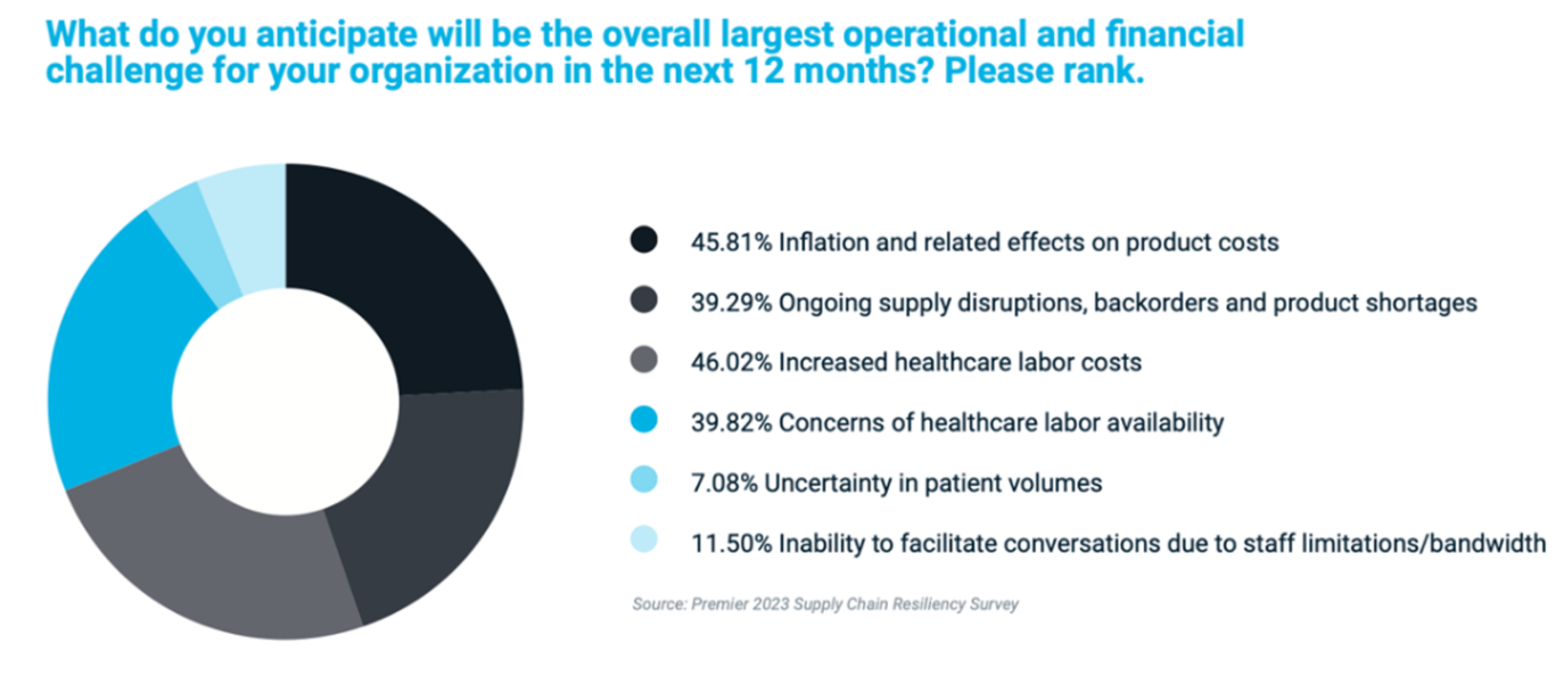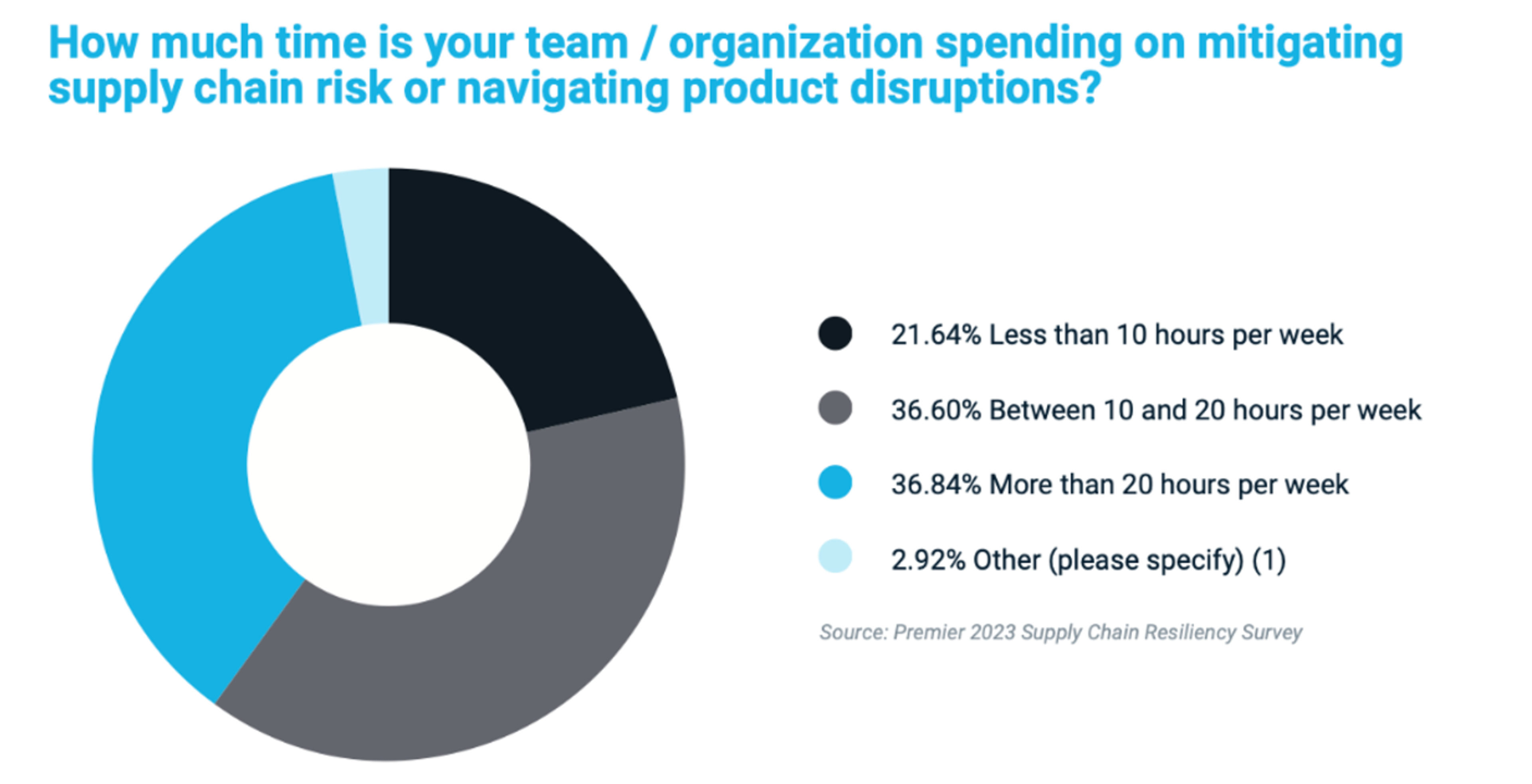New Premier Data Highlights Healthcare Supply Chain Landscape, Challenges and Strategies for Success

Key Takeaways
- Download your copy of Premier’s new 2023 Supply Chain Resiliency Guide today.
- Below is a sampling of data insights from Premier’s 2023 Supply Chain Resiliency Survey and Guide.
- For full survey results, open-ended survey responses and additional information on strategies to bolster the supply chain, download the Guide via the link above.
The last 3+ years have revealed the critical role of the healthcare supply chain and its impact on timely, cost-effective and high-quality patient care. While our industry has made notable progress and improvements in tackling many post-pandemic obstacles, challenges remain.
Recently, hundreds of U.S. healthcare supply chain, operations and clinical leaders from across the industry – and pulling across group purchasing organization (GPO) affiliation – provided valuable insights for Premier’s 2023 Supply Chain Resiliency Survey.
Today, Premier released its inaugural 2023 Supply Chain Resiliency Guide – informed by the survey data and inclusive of trends, insights and recommended strategies to tackle pressing supply chain challenges and enable long-term success for providers.
What follows are some key takeaways for the healthcare supply chain in 2023 and beyond, and some insights and advice about how to address.
1. A still-disruptive landscape.
According to Premier’s survey, more than 75 percent of healthcare and supply chain leaders expect supply chain challenges to worsen or remain the same over the next year. Respondents cite increased labor costs (46 percent) and labor availability (39 percent), inflation (45 percent), and ongoing supply disruptions, backorders and product shortages (39 percent) as top concerns.

Respondents also anticipated a broad range of potential risks for healthcare supply chains this year – including labor, economic and market factors; raw materials availability and costs; and transportation, geopolitical and cybersecurity threats.

Post pandemic, ongoing disruptions continue to drive product shortages and access issues for providers – and many are staple products vital to everyday patient care.
2. Shortages have arguably become more challenging to manage.
Premier data indicates that shortages are largely shifting from multi-year, pervasive issues to an unpredictable revolving door of new products/categories every month.
Premier’s survey insights tell a similar tale. When asked to provide detail on “the top 3 product disruptions over the last 12 months,” respondents provided a robust list of hundreds of unique items – but with many organizations seeing challenges for the same products critical to patient care.
Top product disruptions in the last 12 months (sampling of common responses) include:
- Surgical tourniquets
- Chest tubes and drainage
- Contrast media
- Various IV fluids, tubing and syringes
- Pharmaceuticals, including oncology drugs, albumin, albuterol
Additionally, healthcare providers are 2.5 times more likely to experience shortages on products in unhealthy markets – when a category has two or fewer manufacturers representing 80+ percent of market share, according to Premier data.
3. Shortages impede operations.
The reality of tracking down equivalents to shortage items – and managing their downstream clinical and operational impacts – further burdens healthcare supply chain teams already struggling with inflationary pressures and workforce challenges.
More than 75 percent said their teams are spending 10+ hours per week mitigating supply chain challenges and shortages. Nearly 37 percent said they are spending more than 20 hours and some organizations are reporting 80+ hours spent weekly managing product availability concerns.

Supply chain challenges are also having a direct impact on patient care. Nearly half of respondents (48.6 percent) said they have had to cancel or reschedule cases or procedures at least quarterly in 2022 due to product shortages.

4. Geopolitical tensions and global dependencies.
One of the most critical lessons we learned during the COVID-19 pandemic is that when we outsource too much of our manufacturing and sourcing capabilities overseas, we create vulnerabilities for providers and patients here at home.
The implications of political instability, trade disputes, extreme weather and a host of other potential global disruptions can have far-reaching consequences – affecting the production, distribution, availability and pricing of critical medical devices, pharmaceuticals and other vital supplies. Recent growing tensions between China and Taiwan further add to these concerns.
In light of these concerns, three out of four healthcare and supply chain leaders say domestic manufacturing is an “extremely” or “very important” component to their organizations’ supply chain resiliency strategies, according to Premier’s survey.
Premier recently developed a special report exclusively for our members with in-depth background on the geopolitical landscape and dynamics between China and Taiwan – examining historical tensions, healthcare supply chain vulnerabilities, economic implications and more. This information aims to provide valuable insights for our members to help navigate the complexities of operating in a global supply chain environment.
Solutions to Target Product Availability and Supply Chain Resiliency
The good news? While more work is yet to be done, the healthcare supply chain is evolving to be stronger emerging from pandemic than it was entering it.
Survey insights from a broad cross section of healthcare and supply chain leaders, regardless of GPO affiliation, inform Premier’s 2023 Supply Chain Resiliency Guide to support decision-making on risk prevention and mitigation strategies and comprehensive recommendations for advancing resiliency now and for the future.
For full survey results, open-ended survey responses and additional insights on the strategies providers are focused on to bolster the supply chain, download the Guide via the link at the top of the page.
Premier’s Leadership and Action on Supply Chain Resiliency
After a challenging 3+ years, the road to supply chain success includes innovative sourcing and contracting strategies, creative partnerships and solutions that lower barriers to entry, support cost savings and drive stable supply.
- Enabling both supply chain and financial resiliency, Premier’s industry-leading contract portfolio, initiatives to diversify production and sourcing, disaster preparedness and response program, and our technology suite are serving as a collective shield to help protect members against both shortage and inflation risks.
- Premier recently analyzed ≈500 categories across our MedSurg contract portfolio, and the vast majority are sourced from a geographically diversified supply chain – where critical products either have multiple reported manufacturing locations, or there are multiple contracted suppliers with crossable offerings. Risk assessment is embedded in the DNA of our contracting approach, including data on where product and raw materials are sourced, safety stock requirements, data on quality records and rapid replenishment capabilities.
- Supply chain diversification includes bringing manufacturing back to the USA. Through collaborations with Prestige Ameritech, DeRoyal Industries Inc, Honeywell, PRINCO LLC, VGYAAN Pharmaceuticals and Exela Pharma Sciences, Premier and our members are bolstering domestically made medical supplies and pharmaceuticals for providers and patients – while supporting job creation and stronger local economies. Via these initiatives and leveraging advanced automation capabilities, healthcare providers can diversify supply sources at a price point competitive with overseas manufacturing. In addition, these suppliers have increased their production to help protect providers from shortages.
- Premier’s direct sourcing, digital sales, purchased services and supply chain consulting solutions are allowing our members to gain efficiencies, realize cost savings opportunities and gain access to the critical, high-quality products and services providers need to care for patients.
- Premier’s pharmacy team continues to monitor global supply chain developments and provide our members with innovative solutions and actionable information to mitigate the impact of pharmaceuticals disruptions. See how ProvideGx is helping to tackle drug shortages and enable greater access to at-risk products. And for the latest, comprehensive intelligence on the state of the pharma markets, members can consult the June Drug Shortages update.
- Historically, hospitals lacked the ability to predict when a product might become short. Premier's award-winning Supply Disruption Manager is aiding members in predicting demand surges and product shortages far in advance with over 90 percent accuracy – while extending the efficiency of scarce workforce resources. The solution can afford supply chain and clinical staff reduced time to manage supply stock issues, reduced cost due to changing alternatives and reduced canceled procedures due to inadequate supplies.
- For information on product shortages and disruptions, members can consult the Disaster Preparedness and Response community inclusive of Premier’s weekly product watch list and actionable information for members to help mitigate or prevent clinical disruption. Premier’s Advocacy team continues to work closely with the White House, federal and state agencies and industry organizations on strategies to gather data, forecast demand, identify needed regulatory changes, increase available supplies and allocate based on need.
Writer and philosopher George Santayana famously said: “Those who cannot remember the past are condemned to repeat it.”
Together with our members, Premier remains steadfast in providing innovative solutions for resiliency and risk mitigation, supply continuity, competitive pricing and quality enhancement to help ensure our members maintain access to the high-quality products providers need to care for patients. This commitment will never waver.

David leads the company’s core supply chain business, including sourcing, contract management, operations and business analytics. He also provides executive leadership for the Premier direct sourcing business.

With 15 years of diverse supply chain strategy and operations experience, Kyle leads Premier’s supply chain business process improvement initiatives and has executive leadership responsibility for Premier’s Supply Disruption and Disaster Preparedness and Response efforts.
Article Information

David leads the company’s core supply chain business, including sourcing, contract management, operations and business analytics. He also provides executive leadership for the Premier direct sourcing business.

With 15 years of diverse supply chain strategy and operations experience, Kyle leads Premier’s supply chain business process improvement initiatives and has executive leadership responsibility for Premier’s Supply Disruption and Disaster Preparedness and Response efforts.